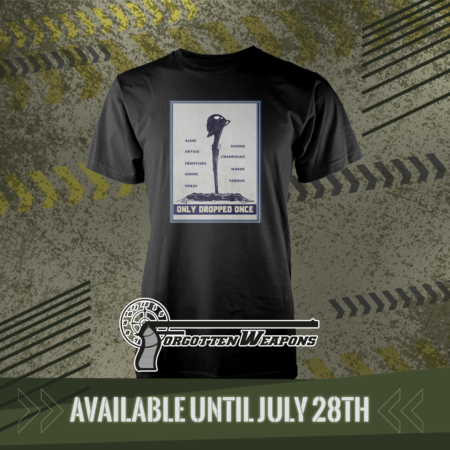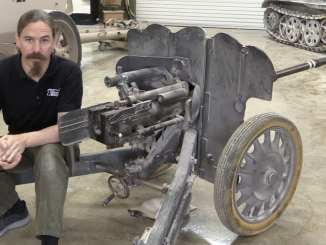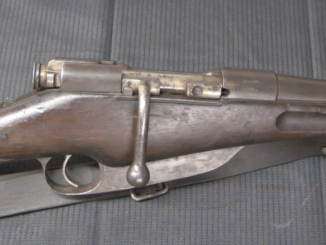The sharpshooters of the French colonial forces in Indochina (the Tirailleurs Indochinois) had never been issued Lebel rifles, and were still using single shot Gras rifles at the turn of the century. The Indochinese soldiers were rather short statured, and the Lebel was simply too long of a rifle for them to use efficiently. The colonial government requested a special weapon for these men, and the result was the 1902 Berthier.
The Berthier carbine was much more compact than the Lebel, and it was also less expensive to manufacture and simpler to instruct troops with. So after some brief experimentation, a version was produced with a 25 inch (635mm) long barrel, which was a nice balance between the carbines and the Lebel rifle. In my opinion, the 1902 is the ideal size for a Berthier, and I think it handles best of all the different variations made.
An initial production run of 22,500 of these 1902 rifles was made by Chatellerault between 1902 and 1912. A second batch of about 25,000 more would be produced in the 1920s, but we will discuss these in a separate video, as they were made with the 1916 upgrades.
With the successful implementation of the Berthier in the Indochinese colonial forces, it would stand out as an obvious solution for the need to upgrade the arms of France’s African colonial troops as well. These soldiers were not short, but also had outdated Gras rifles, and Lebel production was no longer active by 1907. As a result, a further lengthened Berthier was suggested for the Senegalese troops, with a barrel 31.5 inches (800mm) long; equal to that of the Lebel. This was accepted into service, and 25,000 were manufactured by Chatellerault between 1907 and the beginning of the Great War in 1914.
With the urgent need for more rifles because of World War One, the 1907 Berthier (renamed to the 1907 Colonial and issued to colonial troops besides just the Senegalese as of 1908) would attract the interest of the military because it was cheaper to manufacture than the Lebel, and still in active production. The result would be the 07/15 Berthier, which would become a dual standard infantry rifle alongside the 1886 Lebel in the war.





Ergonomics is in the hand of the holder… nice observation, Ian.
Hi Ian,
The “Tirailleurs” units, were not specially sharpshooters. The term “Tirailleur(s) is related with a combat disposition/stance(?), not the regular line infantry for exemple. Skirmisher is closer.
Isn’t “Tirailleur” something like “strzelec”(private – changed to “szeregowy” during postwar soviet occupation) in Second Polish Republic?
ps. in prewar Poland “szeregowy” was only “general term”(consisting of “strzelec”, “ułan”, “saper”, “kanonier”, “legionista”, “strzelec konny”, “szwoleżer” etc.).
“consisting of “strzelec”, “ułan”, “saper”, “kanonier”, “legionista”, “strzelec konny”, “szwoleżer” etc.”
That might be carried over from Austria-Hungary:
http://www.austro-hungarian-army.co.uk/badges/badges.htm
which have ranks like Infanterist, Jäger, Dragoner, Husar, Ulan and Kanonier. In case of Austrian-Hungarian is worth nothing that, so called Paroli was used to show rank, not shoulder strap.
Finnish Army and Air Force (but not the Navy) have also traditionally (since M/36 uniform) used collar patches to show rank in addition to branch color. This style is still used on officers’ dress uniforms and the older M91 pattern camo uniform. The latest M05 uniform switched to more international shoulder strap rank insignias.
If I remember my French correctly, “Tirailleur” is derived from “Tireur”, which was the term applied to the sharpshooters in the revolutionary French army before Napoleon took over.
“Franc-tireur” translates roughly to “free shooter”, and their function was best described by James Burke;
It should be noted that most of those “independent musketeers” were actually armed with largebore sporting rifles taken from the nobility’s estates. And their primary targets were officers on horseback or on foot, gun team captains, noncoms, messengers, runners,buglers, drummers, and standard bearers.
NB: Killing the last three wasn’t just for morale effect. Units back then maneuvered by bugle call and drumbeat; eliminating them severely handicapped command and control. As for the standard bearers, the standard was a unit’s rally point. Killing the guy holding it up increased confusion, especially if you’d already shot down the officers and etc.
When Napoleon took over, he kept the Francs-tireurs, but had them trained more as scouts to find the enemy’s cavalry units, artillery train, supply routes, and etc. and report back. So in his hands, they became a forerunner of the modern-day “scout sniper”.
They were again employed similarly by Napoleon III’s army in the Franco-Prussian War (1870-71). This was probably the “line of descent” to the later “Tirailleurs”.
cheers
eon
Franc-tireur also convinced the Germans that a rabble of bushwhackers–fighting like North American Indians–should be opposed by “Franktireurkrieg,” namely reprisals carried out against civilians who formed the “crowd cover” for such “illegal combatants.” The PCF in WWII named their resistance organization “FTP” for Francs-tireurs et partisans. German reprisals were much harsher, witness Oradour sur Glâne and other butcheries.
“Franc-tireur” is the root of the typical Spanish word for “sniper,” namely “francotirador” or “sharp-shooter.”
I find myself wondering if in addition to the rather more robust stature of the colonial servicemen from what the French called “Western Sudan” or Senegal, Mali, Niger, the Côte d’Ivoire, “Dahomey”/Benin, Guinea, etc. etc. that north of the tse-tse fly habitat armed light cavalry were more typical enemies… And so the Berthier was to be a sort of pike like papa Lebel: A Napoleonic square might be formed what with the fearsome bayonet–blade for the Berthier, knitting needle spike “Rosalie” for the Lebel–facing out against sword, lance, and outdated firearms of France’s many colonial enemies.
It is my understanding that the greater number of mercenaries who served in the Kaiser’s colonial “Askari” forces made do with the Modell 1871 Jägerbuchse shorter rifle or, at least in East Africa, resorted to captured arms as available.
French troops were actually trained to use a “Swiss pike” type square with bayoneted rifles as a defensive formation at the time. It was intended to fend off both cavalry and, in colonial service, native tribe mass attacks.
It was sensibly abandoned for “European” warfare with the advent of the QF gun and the machine gun. The only real defenses against those were either entrenchment, direct assault, or counterbattery fire.
A “square” was simply a large, stationary target.
cheers
eon
Tirailleur is not a “strzelec”, by 1900 the word designed only some indigenous troops of Indochina and Black Africa. By 1900, the metropolitan forces didn’t have more tirailleurs since a long time. By the way, the so-called Senegalese Tirailleurs were far from being all of Senegalese origin…
Originally, the tirailleurs were a kind of light infantry who fought on forefront lines and in a somewhat scattered formation, in opposition to the line infantry.
Tirailleur was also a rank, designating the lowest rank. In the french army, and it’s still true today, there is no general name such as private in the US or UK, each branch has its own term : soldat in the infantry, canonnier in the artillery, sapeur in the ingineers, cavalier in the cavalry etc.
This part brings back long lasting memory of term “riflemen of Senegal”
https://en.wikipedia.org/wiki/Senegalese_Tirailleurs… I heard that first when I was around 10 years old. Yes, long time back.
More I look at and hear story about Berthier rifles, more I like them. They are elegant, simple and well made. Long time gone French firearms fame. Whole series is extremely catchy and I enjoy Ian’s masterful narrative, as always.
Was there any objection to the down-turned bolt handle? It seems to be that it interferes less with staying on sight and on target.For Dreyse/Chassepot etc. you’d have to take the gun down to load the next round. With a repeater, that straight handle would slow your fire, wouldn’t it?
There were, though not before 1915 and only for the infantry 1907-15 rifle. The first 1907-15 bolt handles were bended just like the other Berthiers, but it was soon found that for the infantry the straight bolt handle was much more practical and didn’t slow fire at all. The others Berthiers all kept the bended one, as for cavalry, artillery or engineers a straight bolt handle could be inconvenient.